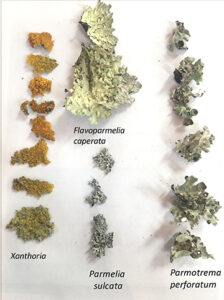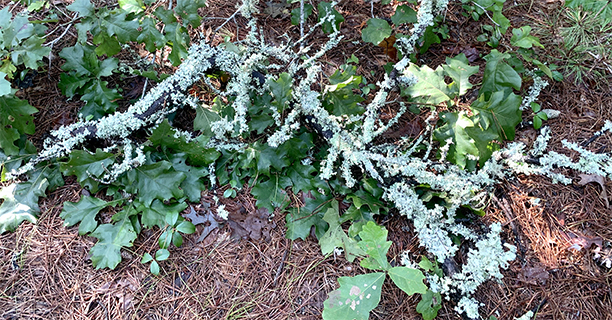When walking in the Vineyard woods in spring, summer, or fall, we mostly notice the leaves: the pale uncurling new ones, the thick canopy of green ones, the yellow and brown ones signaling wintertime. But in the winter, a whole new world engages our attention: the lime-colored haze of the lichens that coat every boulder and every oak tree. They live side-by-side with the mosses, which are a much deeper green.
I’m a retired biologist, living in the Chilmark woods and hence surrounded by lichens. My prior lab research was focused on the sex life of a unicellular alga that lives in the soil, so it was a natural step to shift my focus to lichens, where unicellular algae live in classy edifices constructed by fungi and bacteria, and I’m now actively engaged in writing scientific papers about their architecture.
Each lichen is an organism created by genetically-scripted interactions between three kinds of organisms—a fungus, an alga, and various bacteria. There are some 20,000 different kinds of lichens on the planet and they dominate an estimated 12% of the planet’s terrestrial ecosystems, including arid deserts and vast expanses of arctic tundra. Humans are generally unaware of their existence since they are rarely used for food or fuel. In fact, they can’t really be said to be useful for anything. They just are.
Every lichen is both an organism and a bounded, fully balanced ecosystem. The ecosystem is structured to be resilient, bounding back after periods of desiccation, freezing, and UV bombardment. It does no harm to other organisms or ecosystems, and it is vulnerable to only a few exogenous agents, such as air pollutants, caribou, and certain snails. Lichens have been able to spread throughout the terrestrial world, including its most inhospitable terrains, because they bring their self-sustaining eco-systems with them and because they aren’t in any hurry.
For me, lichens are important metaphors. We humans would do well to let them guide our approaches to planetary habitation.
While there are a variety of types of lichen found on the Island, such as the bright orange lichens, Xanthoria elegans, which can be found on the old gravestones in the wonderful West Tisbury cemetery, only three major kinds of lichens inhabit our woods. Bring along a hand lens if you have one on your next winter walk, to further explore the delicately sculpted lobes and the exuberant fruiting bodies. Here’s a sampling of what you may find:

Lichen display made by Ursula Goodenough, with fellow collector Luca Sanseverino, her 7-year-old grandson.
Usnea strigosa
Usnea strigosa is stiff and spiky and reminds me of a bottle brush. It is pale green and slathers the upper branches of our oak trees.
Flavoparmelia caperata
Flavoparmelia caperata has flat yellow-green lobes.
Parmotrema perforatum
Parmotrema perforatum has large curly dusky-green lobes.


